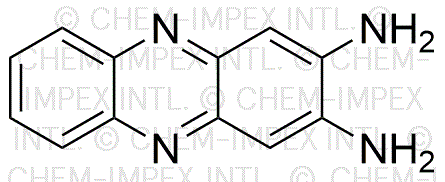Phenazine-2,3-diamine is widely utilized in research focused on:
- Electrochemical Sensors: This compound is often used in the development of electrochemical sensors for detecting various analytes, including glucose and other biomolecules, due to its excellent electron transfer properties.
- Antimicrobial Agents: It has shown potential as an antimicrobial agent, making it valuable in the pharmaceutical industry for developing new treatments against resistant bacterial strains.
- Organic Electronics: In the field of organic electronics, it serves as a key component in organic light-emitting diodes (OLEDs) and organic photovoltaic cells, enhancing their efficiency and stability.
- Fluorescent Dyes: The compound is utilized in creating fluorescent dyes for biological imaging, allowing researchers to visualize cellular processes with high precision.
- Research in Cancer Therapy: Studies indicate its potential role in cancer therapy, where it may contribute to the development of novel chemotherapeutic agents that target specific cancer cells.
Informations générales
Propriétés
Sécurité et réglementation
Applications
Phenazine-2,3-diamine is widely utilized in research focused on:
- Electrochemical Sensors: This compound is often used in the development of electrochemical sensors for detecting various analytes, including glucose and other biomolecules, due to its excellent electron transfer properties.
- Antimicrobial Agents: It has shown potential as an antimicrobial agent, making it valuable in the pharmaceutical industry for developing new treatments against resistant bacterial strains.
- Organic Electronics: In the field of organic electronics, it serves as a key component in organic light-emitting diodes (OLEDs) and organic photovoltaic cells, enhancing their efficiency and stability.
- Fluorescent Dyes: The compound is utilized in creating fluorescent dyes for biological imaging, allowing researchers to visualize cellular processes with high precision.
- Research in Cancer Therapy: Studies indicate its potential role in cancer therapy, where it may contribute to the development of novel chemotherapeutic agents that target specific cancer cells.
Documents
Fiches de données de sécurité (FDS)
La FDS fournit des informations de sécurité complètes sur la manipulation, le stockage et l’élimination du produit.
Spécifications du produit (PS)
Le PS fournit une description complète des propriétés du produit, notamment sa composition chimique, son état physique, sa pureté et les exigences de stockage. Il détaille également les plages de qualité acceptables et les applications prévues du produit.
Certificats d'analyse (COA)
Recherchez des certificats d'analyse (COA) en saisissant le numéro de lot du produit. Les numéros de lot et de lot se trouvent sur l'étiquette d'un produit, après les mots « Lot » ou « Lot de fabrication ».
Numéro de catalogue
Numéro de lot/série
Certificats d'origine (COO)
Ce certificat d'exploitation confirme le pays dans lequel le produit a été fabriqué, et détaille également les matériaux et composants utilisés et s'il est issu de sources naturelles, synthétiques ou autres sources spécifiques. Ce certificat peut être requis pour les douanes, le commerce et la conformité réglementaire.
Numéro de catalogue
Numéro de lot/série
Fiches de données de sécurité (FDS)
La FDS fournit des informations de sécurité complètes sur la manipulation, le stockage et l’élimination du produit.
DownloadSpécifications du produit (PS)
Le PS fournit une description complète des propriétés du produit, notamment sa composition chimique, son état physique, sa pureté et les exigences de stockage. Il détaille également les plages de qualité acceptables et les applications prévues du produit.
DownloadCertificats d'analyse (COA)
Recherchez des certificats d'analyse (COA) en saisissant le numéro de lot du produit. Les numéros de lot et de lot se trouvent sur l'étiquette d'un produit, après les mots « Lot » ou « Lot de fabrication ».
Numéro de catalogue
Numéro de lot/série
Certificats d'origine (COO)
Ce certificat d'exploitation confirme le pays dans lequel le produit a été fabriqué, et détaille également les matériaux et composants utilisés et s'il est issu de sources naturelles, synthétiques ou autres sources spécifiques. Ce certificat peut être requis pour les douanes, le commerce et la conformité réglementaire.

